Journal of Environmental Protection
Vol.5 No.2(2014), Article ID:43226,6 pages DOI:10.4236/jep.2014.52015
Natural and Artificial Radionuclides in River Bottom Sediments and Suspended Matter in the Czech Republic in the Period 2000-2010
1Department of Radioecology, T. G. Masaryk Water Research Institute, Public Research Institution, Prague, Czech Republic; 2Faculty of Science, Institute for Environmental Studies, Charles University, Prague, Czech Republic.
Email: eduard_hanslik@vuv.cz
Copyright © 2014 Eduard Hanslík et al. This is an open access article distributed under the Creative Commons Attribution License, which permits unrestricted use, distribution, and reproduction in any medium, provided the original work is properly cited. In accordance of the Creative Commons Attribution License all Copyrights © 2014 are reserved for SCIRP and the owner of the intellectual property Eduard Hanslík et al. All Copyright © 2014 are guarded by law and by SCIRP as a guardian.
Received November 29th, 2013; revised December 28th, 2013; accepted January 27th, 2014
Keywords: River Bottom Sediments; Suspended Matter; Surface Water; Uranium Industry; Radioactive Contamination; Radium-226; Radium-228; Potassium-40; Caesium-137
ABSTRACT
The concentrations of natural radionuclides, radium-226, radium-228, and potassium-40, and the artificial radionuclide caesium-137, in river bottom sediments and suspended matter were monitored in the Czech Republic by the Czech Hydrometeorological Institute during the period 2000-2010 and 2001-2010 respectively. The data were used to evaluate the natural background levels of these radionuclides and the impact of human activities on the water environment. For potassium-40 in sediments, the natural background level was estimated to be 570 Bq/kg. To evaluate the background level for radium-226, the river sites affected by human activities (mining and processing uranium ore, coal) were eliminated from the assessment. The average natural background values were 47.8 Bq/kg for radium-226 and 47.2 Bq/kg for radium-228 in sediments and 86.5 Bq/kg for radium-226 and 87.9 Bq/kg for radium-228 in suspended matter. The river sediments were identified as good indicators of radioactive contamination, especially radium-226, which recorded historic contamination due to former uranium mining and milling. The radium-226 contamination rate was assessed using the ratio of radium-226 to radium-228. This ratio was used to classify sediment according to the relative contamination from the uranium industry. The residual contamination of caesium-137 due to the Chernobyl accident in 1986 was also assessed. Average values of caesium-137 were 14.0 Bq/kg in sediments and 25.0 Bq/kg in suspended matter.
1. Introduction
Monitoring of radioactive substances in river bottom sediments in the Czech Republic has a long history [1-4]. The permanent monitoring of river bottom sediments and suspended matter, which includes gamma-spectrometric analysis, was initiated in 1999 under a programme carried out by the Czech Hydrometeorological Institute (CHMI). The aim was to improve the knowledge of natural background levels and anthropogenic influences on the content of radionuclides in sediments and suspended matter. The results of the monitoring for the period 2000-2010 and 2001-2010, respectively, are evaluated in the paper.
2. Methods
The monitoring network of river bottom sediments covered the Czech Republic and included 44 river sites (hereinafter referred to as “basic network”). Based on the evaluation of the results in 2004 [5], the monitoring was extended by an additional 33 sites in 2006-2008 (hereinafter referred to as “extended network”), which cover the areas of former uranium and coal mining and processing. The sampling was carried out mainly by staff of CHMI and since 2006 the new sites were also sampled by staff of river basin companies and the T. G. Masaryk Water Research Institute (TGM WRI). The frequency of the sampling was twice per year.
Suspended matter were sampled by using a mobile centrifuge ALFA LAVAL WSB 203B-34 with a pump ALFA LAVAL IP 200 and maximal power 1 800 l/s since the year 2001 [6]. In the period 2001-2005, the sampling was carried out in the same monitoring network as of river bottom sediments (basic network). The monitoring was narrowed to ten selected sites in 2006.
Grain size of the sediment samples was generally less than 2 mm. Samples were analyzed at the Radiological Laboratory of the TGM WRI. Sediment samples were dried at 105˚C, hermetically sealed in containers and measured for the activities of caesium-137 (137Cs), potassium-40 (40K), radium-226 (226Ra) and radium-228 (228Ra) by using gamma-spectrometric methods in accordance with Czech National Standard ISO 10703 (75 7630) [7]. Samples of suspended matter were measured for the activities of 137Cs, 226Ra and 228Ra. The amount of dry sample was about 0.5 kg (sediments) and 1 - 25 g (suspended matter) respectively. The results were expressed in Bq/kg dry sample. The minimum detectable activities (MDA) in the sediments at the 95% level of significance were approx. 0.5 Bq/kg for 137Cs, 10 Bq/kg for 40K, and 2 Bq/kg for the radium radioisotopes. The MDA in the suspended matter at the 95% level of significance was approx. 5 Bq/kg for 137Cs, 20 Bq/kg for the 226Ra and 30 Bq/kg for 228Ra.
Values below the MDA were included in the assessment as they were assumed to equal the MDA. The measured values were used for calculation of annual average activities. Comprehensive assessment of radionuclides in river sediments was done for basic network for the period 2000-2010. The extended network was included only for assessment of impacts of former uranium mining and processing. Assessment of radionuclides in the suspended matter was done only for ten sites where the monitoring was carried out for the whole period 2001-2010.
The monitoring network of river bottom sediments and suspended matter is shown in Figure 1.
3. Results and Their Evaluation
3.1. Caesium-137
The concentrations of artificial radionuclides were assessed by using 137Cs, which represents the residual contamination in the environment after nuclear weapons tests in the atmosphere, mainly in the 1950s and 1960s, and also the nuclear reactor accident at Chernobyl in 1986. The half-life of 137Cs is 30.2 y [8]. Annual average activities in river sediments at the monitored sites ranged from 11.4 to 17.5 Bq/kg, with an average of 14.0 Bq/kg.
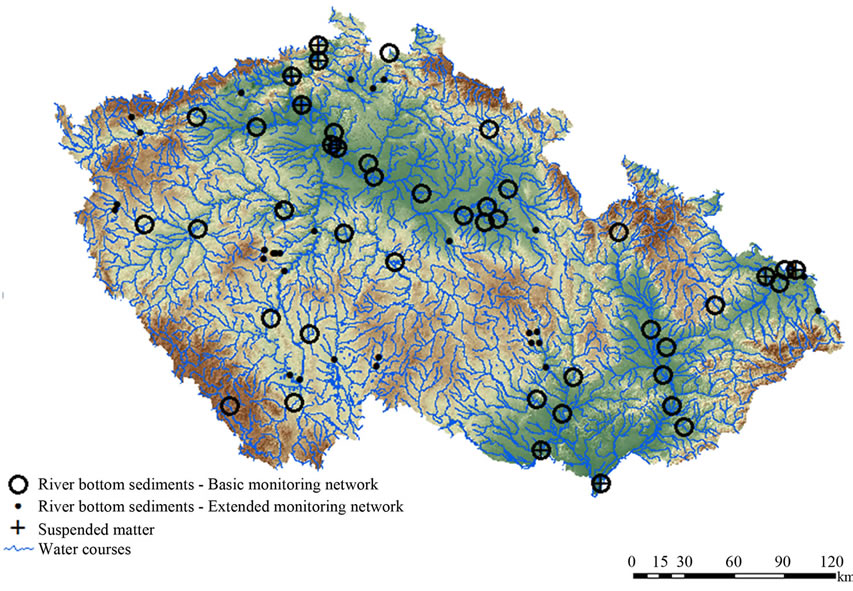
Figure 1. Map of sampling sites.
Differences in the 137Cs concentrations of sediment between the monitored sites correspond to the available information on the distribution in the Czech Republic after the accident at the Chernobyl nuclear reactor [9]. The highest activities of 137Cs, with an average of 87.6 Bq/kg and range from 38.9 to 124 Bq/kg, were detected at the Topělec site on the Otava River.
Annual average activities in suspended matter ranged from 16.8 to 31.4 Bq/kg, with an average of 25.0 Bq/kg. The average activity of 137Cs in the suspended matter was nearly two times higher than that in river sediments.
Further, the assessment of ratio of 137Cs activities in suspended matter and sediments at individual sites was performed. The ratio ranged from 1 to 36.8, with an average 6.2. The activity of 137Cs was higher in suspended matter than in river sediments at all sites.
The data from the basic network were analysed for possible time trends in the 137Cs values (Equation (1)). Statistical significance of regression curve was tested by using F-test. Effective half-life was calculated according to Equations (2) and (3) [10,11]:
 (1)
(1)
where a is radionuclide activity in sediments (Bq/kg); λeff, effective decay constant of 137Cs (1/y); t, time (y); and q, natural logarithm of radionuclide activity in sediments (suspended matter) at the beginning of observation (Bq/kg).
 (2)
(2)
where Teff is effective half-life of 137Cs (y).
 (3)
(3)
where Teco is ecological half-life of 137Cs (y) and TP is physical half-life of 137Cs (y).
The annual average values were used for determining the effective half-life of 137Cs in sediments 23.8 y and ecological half-life 112 y (see Figure 2).
The average decrease in the 137Cs in sediments exceeds that of the physical half-life (30.2 y). We assume that the quicker reduction of 137Cs is caused by natural fluvial and biological processes, and thus that the effective and ecological half-lives are less than the radioactivity decay.
The annual average values of 137Cs in suspended matter were used for determining the effective half-life of 137Cs in suspended matter 11.4 y and ecological half-life 18.4 y (Figure 2). Observed decrease of 137Cs in suspended matter was faster than in sediments.
3.2. Potassium-40
40K is a natural isotope with very long half-life (1.28 × 109 y) (with an abundance of 0.0118%) and classified among the so-called primordial radionuclides (radionuclides which arose with the emergence of the Earth). In the Earth’s crust, it is dispersed homogeneously [8,12]. Observed annual average values ranged from 513 to 605 Bq/kg, with an average of 570 Bq/kg. In the monitoring period, the observed values did not exhibit any significant trend, using Equation (1) (Figure 3).
The results of the monitoring programme in the Czech Republic are in good agreement with the range of 40K activities reported in the literature for sediments and suspended matter, which is 500 - 700 Bq/kg [13].
The assessment of 40K in suspended matter was not performed.
3.3. Radium-226 and 228
The isotopes 226Ra and 228Ra are among the most representative of the natural decay series of uranium and thorium, with half-lives of 1600 y and 5.7 y, respectively [8].
Development of annual average 226Ra activities in river sediments and suspended matter for the period 2000-2010 and 2001-2010 respectively is showed in the Figure 4.

Figure 2. The decrease in annual average 137Cs activities in river sediments and suspended matter for the period 2000-2010 and 2001–2010 respectively.
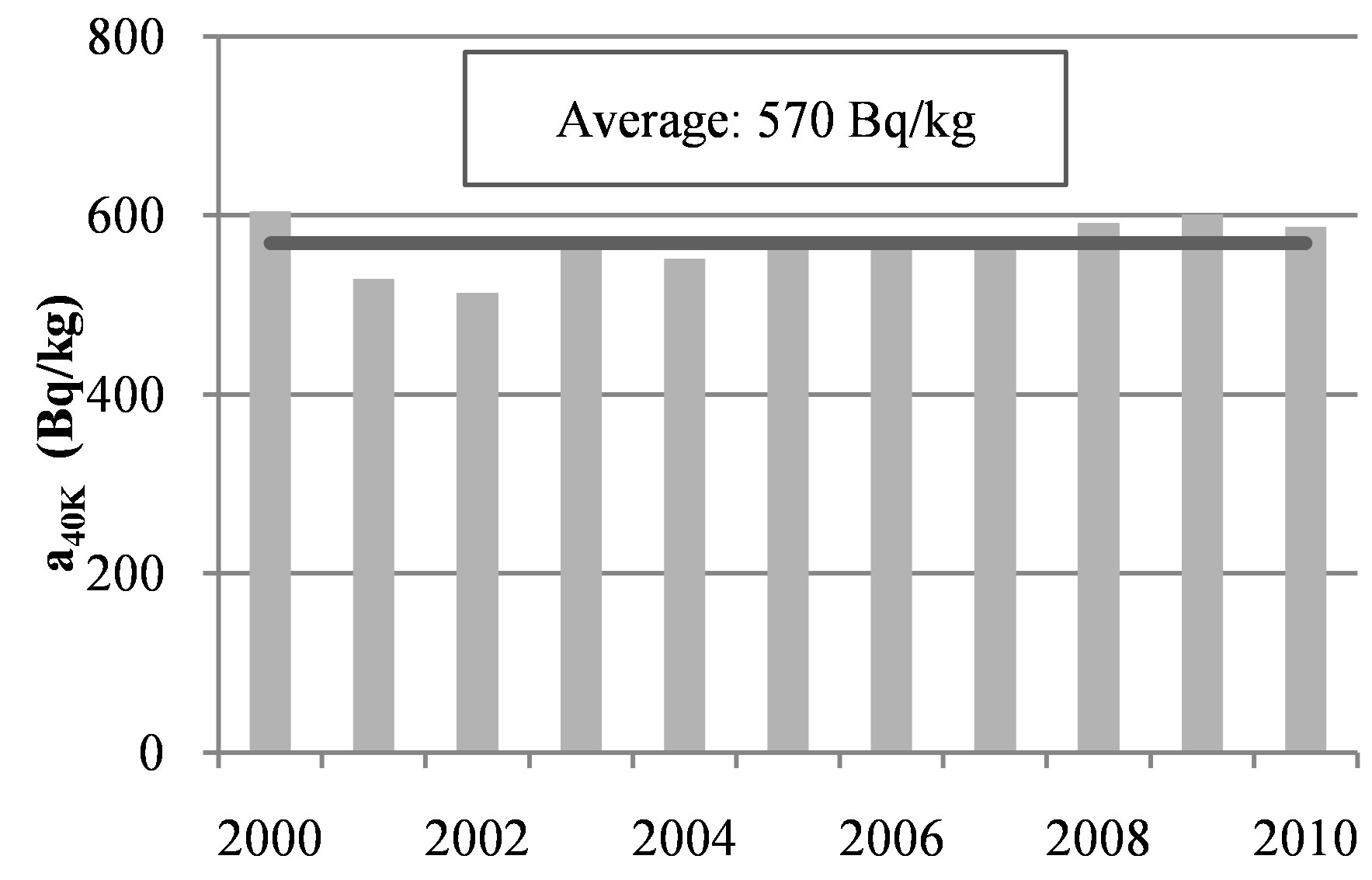
Figure 3. Annual average 40K activities in river sediments for the period 2000-2010.
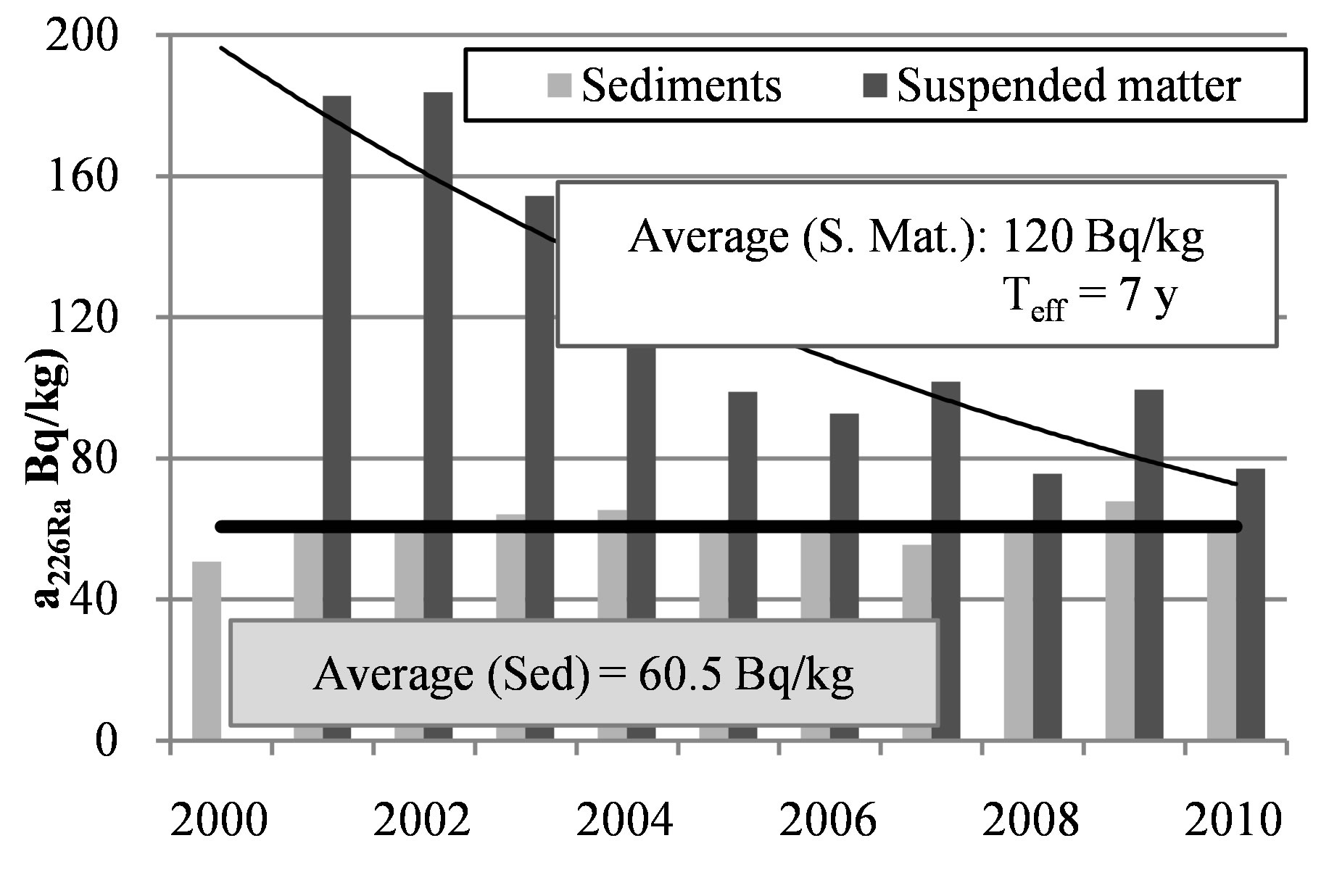
Figure 4. Development of annual average 226Ra activities in river sediments and suspended matter for the period 2000-2010 and 2001-2010 respectively.
Annual average values of 226Ra in river sediments for the whole territory of Czech Republic ranged from 50.8 to 67.9 Bq/kg, with an average of 60.5 Bq/kg. In the monitoring period 2000-2010, the observed annual average values for basic network did not exhibit any significant trend, using Equation (1).
Annual average values of 226Ra in suspended matter ranged from 75.5 to 184 Bq/kg, with an average of 120 Bq/kg. In the monitoring period 2001-2010, the observed annual average values were used for determining the effective half-life of 226Ra in suspended matter 7 y, using Equation (1).
Development of annual average 228Ra activities in river sediments and suspended matter for the period 2000-2010 and 2001-2010 respectively is showed in the Figure 5.
Anthropogenic pollution of the aquatic environment by 228Ra is unlikely, because thorium ores are not mined in the Czech Republic.
Annual average values of 228Ra in river sediments ranged from 40.2 to 53.9 Bq/kg, with an average of 47.2 Bq/kg. In the monitoring period 2000-2010, the observed annual average values of 228Ra for basic network did not exhibit any significant trend, using Equation (1).
Annual average values of 228Ra in suspended matter ranged from 65 to 158 Bq/kg, with an average of 87.9 Bq/kg. In the monitoring period 2001-2010, the observed annual average values were used for determining the effective half-life of 228Ra in suspended matter 9.7 y, using Equation (1).
Observed values correspond to the natural occurrence of 228Ra in watercourses.
Activities of 228Ra in suspended matter are in greater range than activities in sediments. Also decrease of activity of 228Ra in suspended matter exceeded that of the physical half-life at most sites. This we attribute to presence of parent radionuclide 232Th with physical half-life

Figure 5. Development of annual average 228Ra activities in river sediments and suspended matter for the period 2000-2010 and 2001-2010 respectively.
of 1.4 × 1010 y [8]. However decrease of activity 228Ra should be studied in more details.
Additionally was carried out monitoring activity of 226Ra and 228Ra in sediments at sites of former uranium (and coal) mining and processing in the period 2006-2008 (extended network). Observed annual average values 226Ra ranged at these sites from 102 to 133 Bq/kg, with an average of 123 Bq/kg. Observed annual average values of 228Ra ranged from 42.5 to 54.4 Bq/kg, with an average of 49.8 Bq/kg. While average activity of 228Ra for extended network was same as that in other (basic network), average activity of 226Ra was two times greater.
The ratio of 226Ra and 228Ra activities in suspended matter and in sediments was assessed. The ratio of 226Ra activities ranged from 0.3 to 4.6 with an average 1.9. The ratio of 228Ra activities ranged from 0.7 to 6.9 with an average 2.3. Activity of 226Ra and 228Ra was higher in suspended matter in 82 % and 94 % respectively.
Hanslík [14] proposed that it is possible to use the 226Ra:228Ra ratio to identify the degree of radionuclide contamination in the environment from uranium ore (and coal) mining activities. The ratio is around 1.0 in natural samples, while in areas affected by uranium ore mining, it is significantly higher. The activity of 226Ra is increased as a result of contamination, while the activity of 228Ra corresponds to the natural radium levels. On this basis, Hanslík [14] proposed five classes of river sediment contamination by 226Ra according to the 226Ra:228Ra ratio (see Table 1).
These classes were used for classification of river sediments collected in the individual sites in the period 2000-2010. Results from extended network were included to the assessment too. The numbers of the sites in the individual classes are shown in Figure 6.
In the period 2000-2005 and 2009-2010, most of the sites were classified as class I (84% - 91%), i.e. as uncontaminated. In the period 2006-2008, the inclusion of the sites affected by former mining and processing of

Table 1. Classification of river sediments (and suspended matter) contaminated by 226Ra into classes I–V according to the ratio of the activities of 226Ra and 228Ra [14].
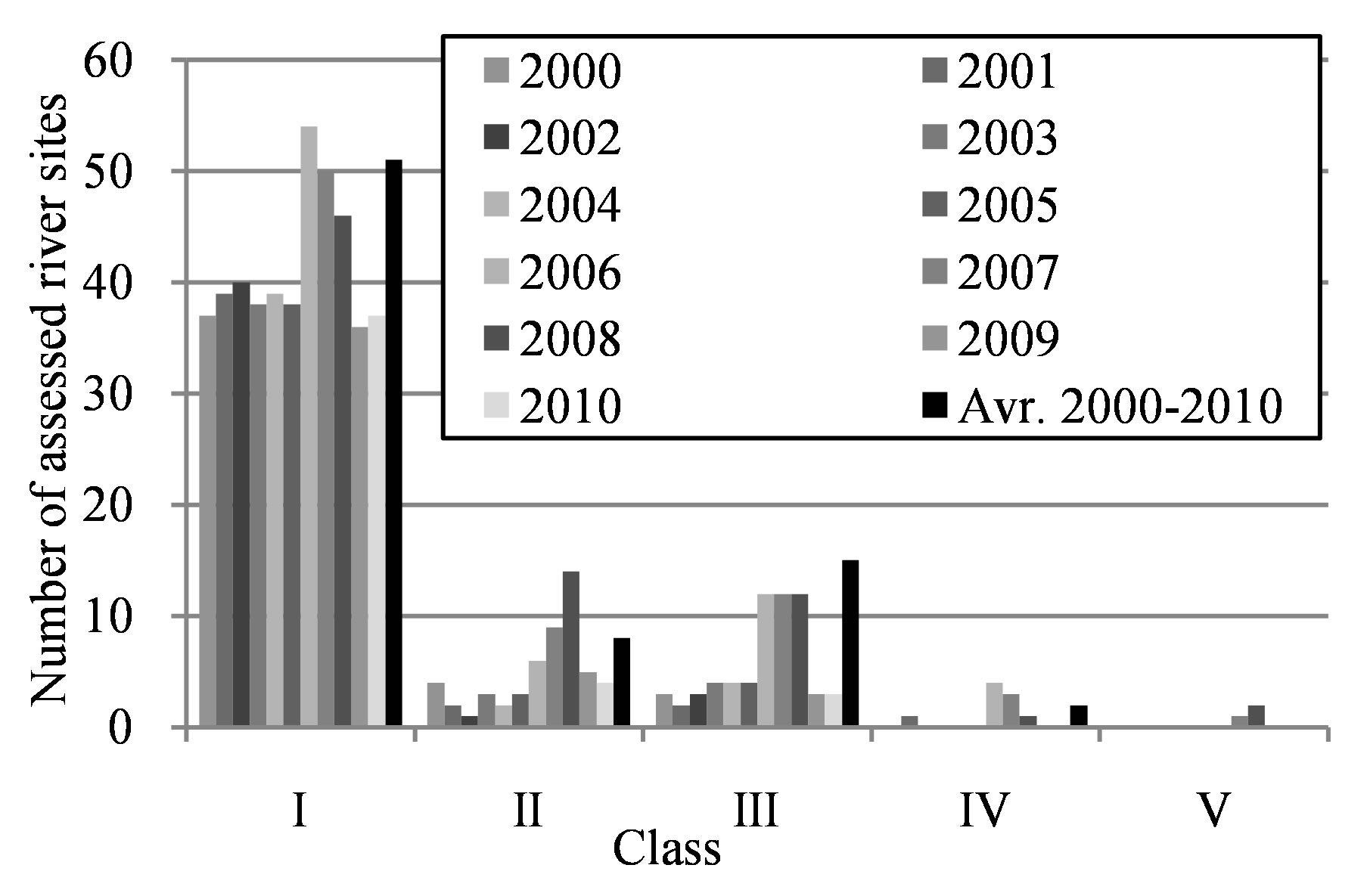
Figure 6. Classification of river sediments into Classes I–V according to the 226Ra:228Ra ratio for annual average activities (see Table 1 for class description).
uranium ore has been reflected by an increase in the representation of contaminated classes.
These classes were used also for classification of suspended matter. The numbers of the sites in the individual classes are shown in Figure 7. Most of the sites were classified as class I (from 50% to 100%) too.
The ratio of 226Ra and 228Ra activities from 5 selected sites with former uranium mining and processing was in average higher in sediments than in suspended matter. Only at one site was evaluated ratio higher in suspended matter. We think it is because of better conditions of water and stopping of mining and on-going mining water treatment respectively.
3.4. Natural Background Levels
The average values were used further to determine natural background levels of radionuclides in the Czech Republic. For 40K, the natural background level was estimated to be 570 Bq/kg. To evaluate the background level for 226Ra, the river sites affected by human activities (mining and processing uranium ore, coal) were eliminated from the assessment, and only river sites falling
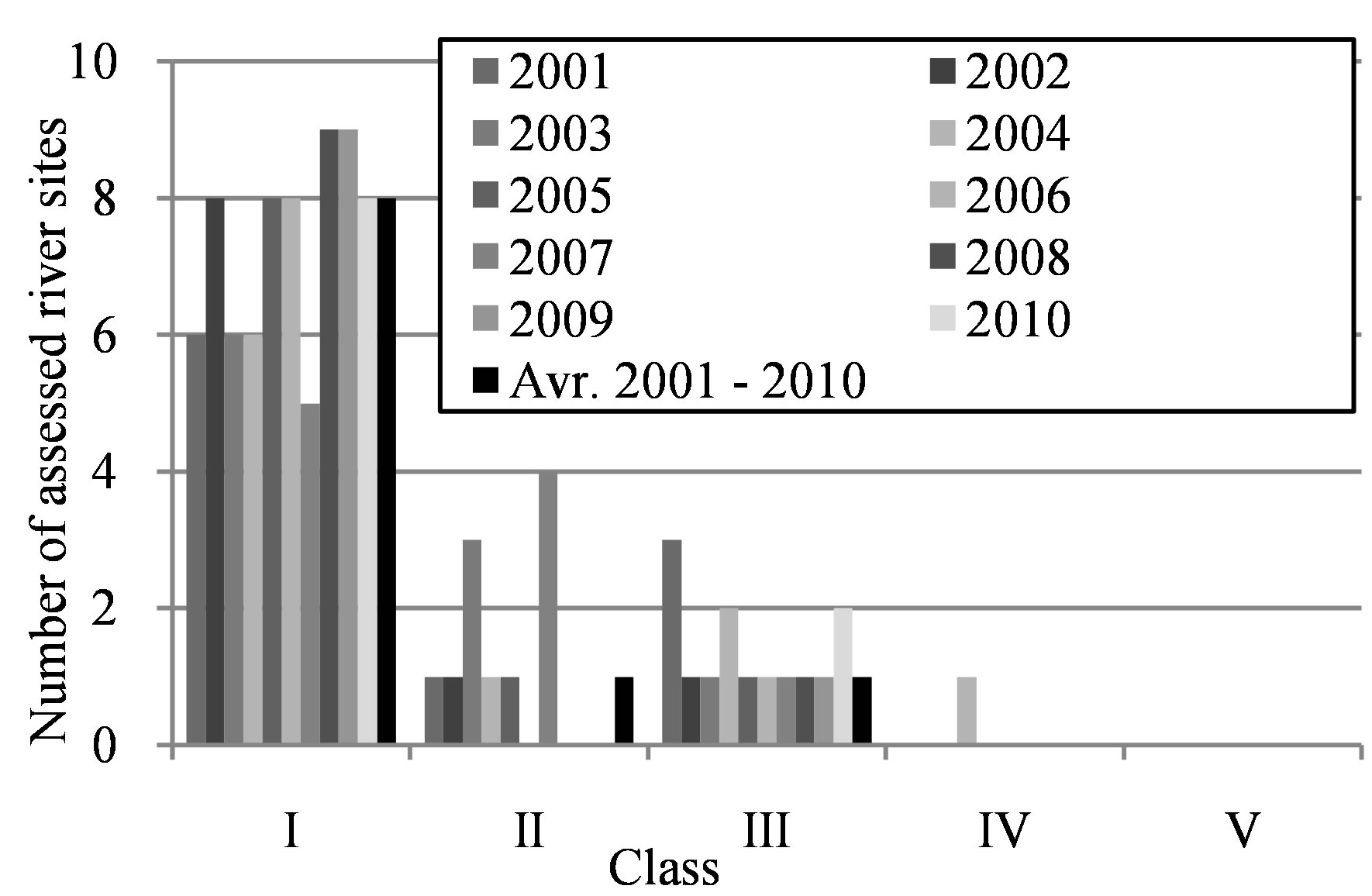
Figure 7. Classification of suspended matter into Classes I-V according to the 226Ra:228Ra ratio for annual average activities.
into class I were used for the analysis. The average natural background values for 226Ra and 228Ra in sediments were essentially identical at 47.8 Bq/kg for 226Ra and 47.2 for 228Ra. In suspended matter it was 86.5 Bq/kg for 226Ra and 87.9 Bq/kg for 228Ra.The uncertainty of the background values was expressed as the standard deviation.
4. Conclusions
Activities of 137Cs, 40K, 226Ra and 228Ra in river bottom sediments and suspended matter were monitored during the period 2000-2010 and 2001-2010 respectively. The mean concentrations of 137Cs in the sediments were 14.0 Bq/kg and 25.0 Bq/kg in the suspended matter. This reflects the residual contamination after nuclear weapons tests and the Chernobyl accident. Annual average values were analyzed for possible time trends in the monitored period. Evaluated effective half-lives of 137Cs in the river sediments were 23.8 y and 11.4 y in the suspended matter respectively. The assessment of ratio of 137Cs activities in suspended matter and sediments at individual sites was performed. The ratio ranged from 1 to 36.8, with an average 6.2. The activity of 137Cs was higher in suspended matter than in river sediments at all assessed sites.
Natural background levels in river sediments were 570 Bq/kg for 40K, 47.8 Bq/kg for 226Ra and 47.2 Bq/kg for 228Ra. In suspended matter it was 86.5 Bq/kg for 226Ra and 87.9 Bq/kg for 228Ra.
In the monitoring period, the observed annual average values of 40K, 226Ra and 228Ra in river sediments from the whole territory of Czech Republic did not exhibit any significant trend. The decrease of annual average values of 226Ra and 228Ra in suspended matter was observed. Evaluated effective half-lives of 226Ra and 228Ra in suspended matter were 7 y and 9.7 y.
The ratio of 226Ra and 228Ra activities in suspended matter and in sediments was assessed. The ratio of 226Ra activities ranged from 0.3 to 4.6 with an average 1.9. The ratio of 228Ra activities ranged from 0.7 to 6.9 with an average 2.3. Activity of 226Ra and 228Ra was higher in suspended matter in 82% and 94% respectively.
The river bottom sediments are still contaminated by 226Ra which stems from mining and processing of uranium ore. Contamination by 226Ra can be assessed by using the 226Ra:228Ra ratio, which is up to 1.5 for unaffected river sites, and exceeds this value for the affected sites. This approach can be used as a complementary assessment to that based solely on the activity of 226Ra to identify sites contaminated by uranium mining and processing.
Acknowledgements
This paper was prepared with the support of the project MŽP CR 0002071101.
REFERENCES
- A. Mansfeld and E. Hanslík, “The Migration of Radionuclides from Nuclear-Power Plants in Surface Waters,” Report TGM WRI, Prague, 1983 (in Czech).
- P. Beneš and L. Nondek, “Analysis of the Contamination of River Sediments in the Elbe River Basin,” Final Report for EU Elbe Project 03.02.07 PF UK, Praha, 1993.
- E. Hanslík, “Impact of Temelín Nuclear Power Plant on hydrosphere,” Research for Practice: Workbook 34, T. G. M. WRI, Prague, 1996 (in Czech).
- E. Hanslík, A. Mansfeld, J. Justýn, V. Moucha and P. Šimonek, “Impact of Uranium Ore Mining on the Development of Contamination of Hydrosphere of the Plou- čnice River during 1966-2000,” Research for Practice: Workbook 45, TGM WRI, Prague, 2002 (in Czech).
- E. Hanslík, E. Kalinová, M. Brtvová, D.Ivanovová, B. Sedlářová, J. Svobodová, V. Jedináková-Křížová, M. Rieder, J. Medek, K. Forejt, L. Vondrák, K. Jahn and J. Jusko, “Radium Isotopes in River Sediments of Czech Republic,” Limnologica—Ecology and Management of Inland Waters, Vol. 35, No. 3, 2005, pp. 77-184.
- M. Rieder and P. Benčík, “Sampling of Suspended Matter by Mobile Sampler in Profiles of National Monitoring Network of Monitoring Water Quality in Rivers,” Proceedings of XVIII. Conference on Radionuclides and Ionizing Radiation in Water Management. ČVTVS Praha, České Budějovice, 2001(in Czech).
- CNS ISO 10703 Water Quality—Determination of the Activity Concentration of Radionuclides—Method by High Resolution Gamma-Ray Spectrometry, ČNI, 2008 (in Czech).
- C. M. Ledererand V. S. Shirley, “Table of Isotopes,” 7th Edition, Wiley-Inter-Science Publication, New York,, 1978.
- E. Hanslík, V. Jedináková-Křížová, D. Ivanovová, E. Kalinová, B. Sedlářová and P. Šimonek, “Observed HalfLives of 3H, 90Sr and 137Cs in Hydrosphere in the Vltava River Basin (Bohemia),” Journal of Environmental Radioactivity, Vol. 81, No. 2-3, 2005, pp. 307-320. http://dx.doi.org/10.1016/j.jenvrad.2004.01.042
- E. Hanslík, P. Šimonek and B. Sedlářová, “Contamination of CR Water after Chernobyl,” Sovak, Vol. 9, No. 4, 2000, pp. 99-102 (in Czech).
- J. T. Smith and N. A. Beresford, “Chernobyl Catastrophe and Consequences,” Praxis Publishing Ltd, Chichester, 2005.
- J. Švec, A. Heribanová, J. Novotná, J. Filip, L. Mrázek, H. Žárská, O. Bezděková, J. Rada, V. Hušák and Z. Pašková, “Protection When Working with Sources of Ionizing Radiation,” Proceedings of Textbooks, Důmtechniky Ostrava, SPOL. SR. O., 2003 (in Czech).
- H.Mundschenk,“Occurrence and Behaviour of Radionuclides in the Moselle River-Part I: Entry of Natural and Artificial Radionuclides”, Journal of Environmental Radioactivity, Vol. 30, No. 3, 1996, pp. 199-213. http://dx.doi.org/10.1016/0265-931X(95)00009-Y
- E. Hanslík, “Radioactive substances,” Newsletter of Main Research and Coordination Department for Elbe Project No. 14, T.G.M WRI, Prague, 1997 (in Czech).

